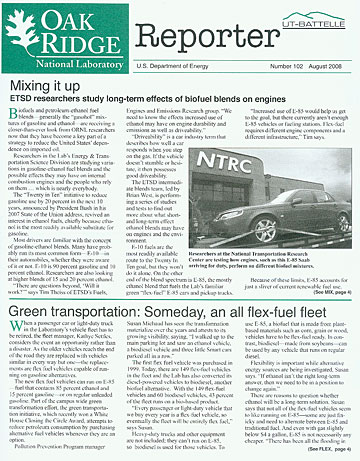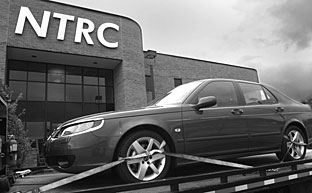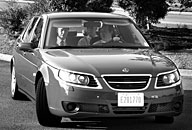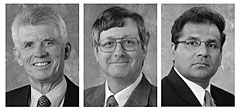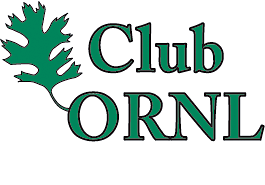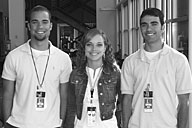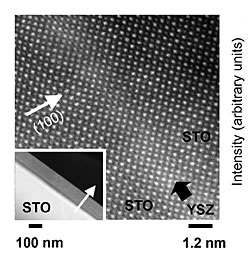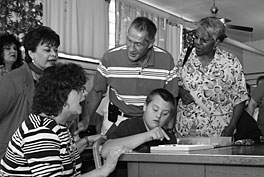 |
Number 102, August 2008 |
 Mixing it up
Mixing it up
ETSD researchers study long-term effects of biofuel blends on engines
|
|
Researchers at the National Transportation Research Center are testing how engines, such as this E-85 Saab arriving for duty, perform on different biofuel mixtures. |
Biofuels and petroleum-ethanol fuel blends—generally the “gasohol” mixtures of gasoline and ethanol—are receiving a closer-than-ever look from ORNL researchers now that they have become a key part of a strategy to reduce the United States’ dependence on imported oil.
Researchers in the Lab’s Energy & Transportation Science Division are studying variations in gasoline-ethanol fuel blends and the possible effects they may have on internal combustion engines and the people who rely on them … which is nearly everybody.
The “Twenty in Ten” initiative to reduce gasoline use by 20 percent in the next 10 years, announced by President Bush in his 2007 State of the Union address, revived an interest in ethanol fuels, chiefly because ethanol is the most readily available substitute for gasoline.
Most drivers are familiar with the concept of gasoline-ethanol blends. Many have probably run its most common form—E-10—in their automobiles, whether they were aware of it or not. E-10 is 90 percent gasoline and 10 percent ethanol. Researchers are also looking at higher blends of 15 and 20 percent ethanol.
“There are questions beyond, ‘Will it work?’” says Tim Theiss of ETSD’s Fuels, Engines and Emissions Research group. “We need to know the effects increased use of ethanol may have on engine durability and emissions as well as driveability.”
“Driveability” is a car industry term that describes how well a car responds when you step on the gas. If the vehicle doesn’t stumble or hesitate, it then possesses good driveability.
The ETSD intermediate blends team, led by Brian West, is performing a series of studies and tests to find out more about what short- and long-term effect ethanol blends may have on engines and the environment.
E-10 fuels are the most readily available route to the Twenty In Ten goal, but they won’t do it alone. On the other end of the blend spectrum is E-85, the mostly ethanol blend that fuels the Lab’s familiar green “flex-fuel” E-85 cars and pickup trucks.
“Increased use of E-85 would help us get to the goal, but there currently aren’t enough E-85 vehicles or fueling stations. Flex-fuel requires different engine components and a different infrastructure,” Tim says.
Because of these limits, E-85 accounts for just a sliver of current renewable fuel use.
Another path to increased use of renewables is in the mostly untrodden territory of E-15 and E-20 blends. That’s where DOE and the transportation industry want to know more.
You can put E-20 in an old car, run it and feel assured that it’s OK. But it may be doing subtle things that cause problems. |
Currently E-10—10 percent ethanol—is the legal limit for conventional gasohol blends. Mixtures of 15 and 20 percent might also work fine, but more needs to be known before government and industry make a commitment that affects something as economically vital as the transportation sector.
“You can put E-20 in an old car, run it and feel assured that it’s OK. But it may be doing subtle things that cause problems, such as prematurely aging the catalytic converter,” says Ron Graves, who leads the Lab’s Fuels, Engines and Emissions Research Center at the National Transportation Research Center on Pellissippi Parkway.
While the introduction of intermediate blends of E-15 and E-20 to the market would provide a step toward the Twenty In Ten goal that E-10 can’t meet on its own, questions have to be answered.
“We’re doing in-house planning as well as working with the National Renewable Energy Laboratory, looking at what questions we need to be asking and what research is needed. ORNL is working with industry to develop research programs and test plans. For example, we’re developing a well-defined protocol for assessing catalyst aging,” Ron says.
Ethanol as a fuel requires an expanded knowledge base because, although it burns like gasoline and appears to run OK in automobiles, it is a very different chemical from petroleum. There are a number of unknowns when it comes to how its use may affect the scrupulously engineered systems in today’s automobiles. Add to that complexity a different set of ethanol mixes.
“These are subtle things, like catalytic converter durability. The higher blends can make the catalysts in some vehicles achieve higher peak temperatures. There are concerns that it might damage the catalyst, but we don’t know yet what the effect really is,” Tim says.
Ethanol also mixes with water (gasoline doesn’t), which means it has a corrosive effect on some components, especially in the fuel system. That’s a major difference in some flex-fuel and conventional car components.
The issues don’t stop with the transportation sector. Also at stake is a $2 trillion small-engine market—the lawn mowers, chain saws, line trimmers and leaf blowers that also depend on gasoline, or whatever we’ll be buying at filling stations in the years ahead.
“For one thing, while unburned hydrocarbon emissions go down, nitrogen oxide (NOx) emissions go up along with operating temperatures, “ Tim says.
With small engines, durability and safety are the most overriding concern of both government regulators and industry. ORNL is also studying emissions and operability as well as materials compatibility with different forms of gasohol.
Tim notes that performing experiments on small engines, such as leaf blowers, isn’t as simple as going to the hardware store and purchasing a dozen leaf blowers to test.
“We’ve seen a lot of variability in performance among individual units,” Tim says. “The variability makes it hard to discern the real effects of the fuel.”
Other non-road vehicles that are potential ethanol burners include high-end motorboats and farm equipment, which represent significant capital investments.
While E-10 has been on the market for some time (and is currently being reintroduced into the Southeast,) very little is known about how E-20 blends perform and almost nothing about E-15. The potential is there; the E-10 limit is not absolute and can be expanded.
“We do believe that cars won’t roll over and die on E-11,” Tim says.
ORNL’s transportation researchers are in the thick of the hunt for data that will enable a faster and more effective expansion of ethanol into the fuel supply. To meet the ambitious goals set by the Energy Independence and Security Act, which calls for 36 billion gallons of renewable fuel by 2022, and to meet the Twenty in Ten goal, science and industry will have to address myriad questions and concerns. DOE and the national labs are on it.
“It’s significant that we have different DOE labs such as ORNL and NREL, and different DOE programs, such as the Vehicle Technologies and Biomass programs, working together this closely on this problem,” says Ron Graves.—B.C. ![]()
|
||
|---|---|---|
Most who have driven one of the Lab’s “flex-fuel” cars don’t notice any particular difference in how it runs, except for one thing: On an extended trip, the fuel needle drops much more quickly. |
 Sign of the times:
fueleconomy.gov hits soar
Sign of the times:
fueleconomy.gov hits soar
|
Consumers worried about high gasoline prices have an ally in an ORNL-run Website focused on fuel economy.
The Environmental Sciences Division’s Bo Saulsbury says that over the past eight years the site, www.fueleconomy.gov, has gone from 4,000 users on a good day to a current average of 80,000 users a day. The Fuel Economy Information Program outstripped its initial goal of 10 million visits in a year about two years ago and has since almost tripled that number.
The Website, created and maintained by ORNL for the DOE’s Office of Energy Efficiency & Renewable Energy and the Environmental Protection Agency, was started in 1999 to provide accurate vehicle miles per gallon information to consumers. The site still provides the Fuel Economy Guide, a yearly publication that is required by law to be made available at every car dealership. But the Website has gone far beyond the guide and is now giving consumers all kinds of fuel and energy-related information.
Fueleconomy.gov has fuel economy tips for just about any driver: from car owners interested in eking maximum efficiency out of their current cars to consumers shopping for a new fuel-efficient car or truck.
At first, says Bo, it was difficult to get people to visit. Gas prices were low and there wasn’t a huge incentive to compare fuel economies before purchasing a car. Now the website’s tool that helps consumers find and compare cars based on gas mileage, greenhouse gas emissions and safety information is one of the most popular resources on the site.
Consumers can search for cars based on model, year, fuel consumption or class. Once the search is narrowed, cars can be compared side by side, displaying differences in mpg, cost of a fill-up, miles per tank and annual fuel cost. The differences can be substantial; the extra gas guzzled by a Subaru station wagon compared with a Toyota Corolla can amount to almost $700 per year, and switching to a Nissan minivan could cost an additional $600 a year in fuel.
But the site really isn’t about telling people what they should drive, says Bo. “We’re giving them the information to make the best choices within the type of car or truck that they need.”
The “Your MPG” tool can help you keep track of your vehicle’s gas consumption. Perfect for those who have always been suspicious of miles per gallon estimates, or just like to keep their own records, the tool lets drivers enter and share gas mileage data. While the fuel economy will vary based on car upkeep and driving habits (there’s advice on those behaviors, too), one can be assured that the info is coming from a real person driving on real roads, not from an artificial test. And once you sign up, you can track your own and share your data.
Bo says that a number of things have coincided to bring huge numbers of people to the site: “Sure, the price of gas has not hurt. But continuing efforts over the years to inform media outlets of our presence and willingness to supply information is really paying off as well. And we are not complacent; we are constantly looking for ways to make the Website better.”
They recently formatted a version for the mobile market; aimed at consumers out shopping for a new or used car, the fuel economy data for cars from 1985 to 2008 can be viewed using a cell phone or other mobile device with a connection to the Internet.
Says Bo, “The goal of the program is to get the information out there; that is our sole purpose – to get the information to the consumer.”—Sarah Wright ![]()
 Green transportation: Someday, an all flex-fuel fleet
Green transportation: Someday, an all flex-fuel fleet
When a passenger car or light-duty truck in the Laboratory’s vehicle fleet has to be retired, the fleet manager, Kathye Settles, considers the event an opportunity rather than a disaster. As the older vehicles reach the end of the road they are replaced with vehicles similar in every way but one—the replacements are flex fuel vehicles capable of running on gasoline alternatives.
The new flex fuel vehicles can run on E-85 —fuel that contains 85 percent ethanol and 15 percent gasoline—or on regular unleaded gasoline. Part of the campus wide green transformation effort, the green transportation initiative, which recently won a White House Closing the Circle Award, attempts to reduce petroleum consumption by purchasing alternative fuel vehicles whenever they are an option.
Pollution Prevention Program manager Susan Michaud has seen the transformation materialize over the years and attests to its growing visibility, saying, “I walked up to the main parking lot and saw an ethanol vehicle, a biodiesel vehicle and three little Smart cars parked all in a row.”
The first flex fuel vehicle was purchased in 1999. Today, there are 149 flex-fuel vehicles in the fleet and the Lab has also converted its diesel-powered vehicles to biodiesel, another biofuel alternative. With the 149 flex-fuel vehicles and 60 biodiesel vehicles, 43 percent of the fleet runs on a bio-based product.
“Every passenger or light-duty vehicle that we buy every year is a flex-fuel vehicle, so eventually the fleet will be entirely flex fuel,” says Susan.
Heavy-duty trucks and other equipment are not included; they can’t run on E-85, so biodiesel is used for those vehicles. To use E-85, a biofuel that is made from plant-based materials such as corn, grain or wood, vehicles have to be flex-fuel ready. In contrast, biodiesel—made from soybeans—can be used by any vehicle that runs on regular diesel.
Flexibility is important while alternative energy sources are being investigated, Susan says. “If ethanol isn’t the right long-term answer, then we need to be in a position to change again.”
There are reasons to question whether ethanol will be a long-term solution. Susan says that not all of the flex-fuel vehicles seem to like running on E-85—some are just finicky and need to alternate between E-85 and traditional fuel. And even with gas slightly below $4 a gallon, E-85 is not necessarily any cheaper. “There has been all the flooding in the Midwest this summer, and gas has been as high as $150 a barrel, so they’re both going up as fast as they can—it’s a race to the top.”
For now, ethanol still seems to be a good solution because it is made from local products, supporting our farmers and the country’s fledgling bio-energy industry. It also reduces our dependence on foreign oil and cuts tailpipe emissions. Speaking about the choices involved in the greening of the vehicle fleet, Susan says that although the answer remains unknown, “We’re going toward the answer.”
Susan also says the initiative has been a learning process, like anything you start from scratch. “All of these projects and getting the [White House Closing the Circle] award involved a lot of different people being creative, open-minded and doing their jobs a little bit differently.”
|
Green transportation is not just about vehicles. |
The green transportation initiative introduces and encourages a full range of alternative transportation habits. Says Susan; “It’s not just about the vehicles; there’s walking, the taxi service and we’d like as many people as possible to car-pool. We try to make it easy; we have a car-pool partner-searching site at https://home.ornl.gov/~fli/.”
The Smart Trips program incorporates an emergency taxi service that many people don’t know about, she says: “If you’ve car-pooled to work and an emergency comes up, you can get a taxi ride home at no cost. There’s a safety net; and even if you only car-pool once or twice a week, that reduces your fuel consumption by 10 or 20 percent.”
Susan has other ideas.
“Y-12 has gone to a four-day work week; that or telecommuting one day a week would cut fuel use by 20 percent without doing anything else,” she says. The bike parking lot is another place to save a few miles. “How many places can you park and ride six flat miles on a shoulder to work, so you’re not too sweaty and it’s safe?” asks Susan.
“It takes looking at the issues with new vision … trying to think of options that are safer, healthier, and better for the environment,” Susan says.—Sarah Wright ![]()
 Bass, Daw, Goyal named corporate fellows
Bass, Daw, Goyal named corporate fellows
|
||
| Bass | Daw | Goyal |
Three researchers have been named UT-Battelle Corporate Fellows. B. Richard Bass, C. Stuart Daw and Amit Goyal were each recognized for sustained outstanding achievements in their scientific and technical fields.
“I am pleased to see Richard, Stuart and Amit attain the rank of corporate fellow, the Lab’s highest designation for scientists and engineers,” says Director Thom Mason. “Their career accomplishments are of the highest caliber, and their work has enhanced ORNL’s reputation for scientific excellence and leadership.”
Richard Bass is recognized for outstanding scientific, programmatic and institutional contributions to the Lab in advanced computational structural mechanics and nuclear safety technologies. He is a world leader in the development and application of advanced computational methods and computer codes for structural analyses of complex components including nuclear reactor pressure vessels.
Richard joined the Lab in 1976 after obtaining his doctorate from Tulane University and holding faculty appointments at the University of Wales and Old Dominion University. His work has resulted in more than 200 technical publications and has been incorporated into regulations and national consensus codes. He currently manages the U.S. Nuclear Regulatory Commission program that develops probabilistic structural safety assessment technology for nuclear power plants.
Stuart Daw pioneered the application of chaos theory and nonlinear dynamics to energy technologies, including gas-fluidized beds, internal combustion engines and pulsed combustion. His groundbreaking efforts in developing practical uses for chaos theory in engineering applications have been widely recognized in industry. He is also recognized for his innovative work in the analysis and modeling of a broad range of engineering systems, including fossil-fuel combustion, hazardous waste treatment, transportation propulsion, emissions controls and nuclear fuel production.
Stuart joined the Lab in 1979 after working as a process development engineer for six years at DuPont. He earned a doctorate in chemical engineering from the University of Tennessee in 1985, has been issued 12 patents with two more pending and is the author or coauthor of more than 170 technical
publications.
Amit Goyal’s research has had a profound impact on the field of high-temperature superconductivity, both in fundamental materials science and in the transition of scientific discoveries from the laboratory to the marketplace. His innovations have provided elegant solutions to achieving essentially single-crystal-like behavior in long lengths of superconducting material, using techniques that are industrially scalable and cost effective, as well as in creating self-assembled, nanoscale defects within superconductors that dramatically enhance their properties. He is widely regarded as an international leader in the fields of high-temperature superconducting materials, texture development in materials and electron backscatter diffraction.
Amit joined the Lab as a postdoctoral fellow in 1991 after completing his doctorate at the University of Rochester. He has published more than 300 technical publications including over 30 invited book chapters and papers and has co-edited six books. He has 53 issued patents, the most of any researcher at ORNL. His awards include the Distinguished Scholar Medal from the University of Rochester, Pride of India Award, two R&D 100 awards, ORNL Inventor of Year (twice), and Battelle Distinguished Inventor. He is a fellow of the American Association for the Advancement of Science, ASM International, the American Ceramic Society, the World Innovation Foundation (UK) and the Institute of Physics (UK).
The three appointments bring the number of current UT-Battelle Corporate Fellows to 28. ![]()
 Club ORNL: Drama, nature, golf
Club ORNL: Drama, nature, golf
|
Cumberland County Playhouse: First Baptist of Ivy Gap (09/06/2008). Join Club ORNL at the Cumberland County Playhouse Saturday, September 6, for First Baptist of Ivy Gap. It starts at 7:30 p.m. (central time) at the O’Brien Adventure Theater. Cost is $15 per ticket, limit four, and will not include transportation. Reservations starting August 11 at 9 a.m. by e-mail only to Gail Okulczyk (okulczykgm@ornl.gov).
Back To Nature: Fall Creek Fall State Park (September 20-21). Join your co-workers on September 20-21 for a trip to Fall Creek Falls State Park. Cost includes lodging in Fall Creek Falls Inn on Saturday night and a buffet breakfast at the Inn on Sunday. Transportation will not be provided. The rate is $40 per person based on double occupancy; $30 per person if more in room (maximum four). Contact Linda Stansberry (stansberryl@ornl.gov).
Golf Tournament at Oak Ridge County Club (October 9). Registration to be announced. Contact Joan Lawson.
Fall Festival & Craft Show (October 30). Registration to be announced. Contact Peg Tinnel.
Oak Ridge Playhouse: Peter Pan (November 27). Registration to be announced. Contact Leigha Edwards.
Ice Skating (December 19). Registration to be announced. Contact Ross Toedte.
Get the latest news on Club ORNL online via the ORNL home page and on ORNL Today. Retirees, to gain access to the ORNL home page, first register in XCAMS by going to http://www.ornl.gov/adm/clubornl_signup.shtml. After receiving your XCAMS account and Club ORNL membership, you can then go directly to https://www.ornl.gov/adm/clubornl. Ross Toedte, 574-1912, toedterj@ornl.gov, is the retiree point of
contact.
 |
 Building 3147: Here comes the sun
Building 3147: Here comes the sun
Construction started recently at the intersection of Fifth Street and Bethel Valley Road on a photovoltaic array—a solar panel—that’s going to be one of the largest and most efficient in the state. Its output will help power an entire ORNL office building.
The big solar panel will be 288 feet long by 10 feet wide and will generate 51.25 kilowatts at peak power. The solar collectors, made by SunPower and installed by Lightwave Solar Electric based in Nashville, are the best available, operating at 18.7 percent efficiency. For comparison, the array in the quad operates at 13 percent efficiency.
“If this array were constructed with the same modules as the one in the quad, it would have to be another 100 feet long to achieve the same electrical output,” says project leader Curt Maxey. “We are using the highest efficiency solar module with the highest capacity available.”
The power will be attached to the grid “node” that supplies the two-story Building 3147. Already an Energy Star-rated building, the structure will strive to become a zero-energy building by combining waste-heat recovery and other energy-efficiency techniques to offset the electrical load into the building.
|
Artist’s depiction of the solar array at Bethel Valley Road and Fifth Street. |
Curt knows of two other arrays in Tennessee of similar size, one in Chattanooga and the other in Memphis.
“Power from this particular array will also be used to do research into power inverter technology and electric power distribution,” Curt says. “From the standpoint of our DOE sponsor, it’s good to demonstrate an actual, functioning office building as a component of the sustainable campus initiative.”
 Ramey interns
constitute a crowd
Ramey interns
constitute a crowd
|
Ramey triplets (from left) Jason, Kelley and Lucas carpool with Mom. |
The daily commute to the Lab feels more like a family outing for the Rameys. The triplets of Dan and Joanne Ramey, of the Nuclear Science & Technology and Materials Science & Technology divisions, are working here as student interns this summer.
“Dad comes to work at about 5 a.m., so we ride with Mom,” says Jason, who has been looking at the durability of manipulators used in hot cells as part of his summer project.
The triplets are used to being around one another: During the school year they all attend Tennessee Tech, where Jason and Lucas are roommates, with Kelley just a few steps away in the next apartment. “People are really surprised at how well we get along, although sometimes we do get on each other’s nerves,” says Lucas, who has been working on a nuclear forensics project.
Kelley, who has been testing different scintillator materials for detecting radioactivity, takes full credit for encouraging her brothers to apply for the internships: “I was here last summer and told them what I got to do and how interesting it was,” she says.
They agree unanimously that the summer internships have been great. “We’ve gotten to see what researchers do, taking tours and participating in the research ourselves, so it gives us a better idea of what a career like this would entail,” says Lucas, with Kelley and Jason nodding in unison.
 Critter update: Where eagles fly
Critter update: Where eagles fly
|
|---|
Dean Campbell caught this bald eagle with a telephoto lens from a moving boat on Melton Hill Lake. |
ORNL’s wildlife management group and the Tennessee Wildlife Resources Agency have been conducting a month-long deer
population study, involving night surveys along certain roads and trails and includes spotlighting the deer.
ORNL wildlife manager Neil Giffen says the study is to give wildlife managers a better fix on the number of deer on the Oak Ridge Reservation, the areas they concentrate in and the effect the annual ORR hunts are having on the population.
“It will also give us ideas on where there are higher concentrations of deer than other areas,” Neil says. “This will help us and TWRA with future management studies.”
Meanwhile, The ORR’s prolific Canada geese are experiencing their second year of managed hunts on the ORR, in the Freels Bend and Solway Bend areas. There should be plenty of them to go around, and they are subject to the same radiological checks that the deer and turkey hunts require.
Another bird recently spotted on the ORR was bagged only with a camera. Dean Campbell, a safety officer with the Nonreactor Nuclear Facilities Division, saw a bald eagle perched in a dead pine tree on Melton Hill Lake in the cove visible from Bethel Valley Road. Not too many years ago the fear was that the nation’s emblematic bird would no longer be found in the wild.
“There aren’t a lot of them, but we see more and more,” says Neil.
Reported by Sarah Wright and Bill Cabage |
|
||
|---|---|---|
The material, a superlattice developed by researchers in Spain, improves ionic conductivity near room temperature by a factor of almost 100 million, representing “a colossal increase in ionic conduction properties,” says Maria Varela of the Materials Science and Technology Division, who characterized the material’s structure with senior researcher Stephen Pennycook. The analysis was done using their 300 kilovolt Z-contrast STEM, which can achieve aberration-corrected resolutions near 0.6 angstrom, until recently a world record. The direct images show the crystal structure that accounts for the material’s conductivity. “It is amazing,” says Maria. “We can see the strained, yet still ordered, interface structure that opens up a wide pathway for ions to be conducted.” Solid oxide fuel cell technology requires ion-conducting materials —solid electrolytes—that allow oxygen ions to travel from cathode to anode. However, existing materials have not provided atom-scale voids large enough to easily accommodate the path of a conducted ion, which is much bigger than, for example, an electron. “The new layered material solves this problem by combining two materials with very different crystal structures. The mismatch triggers a distortion of the atomic arrangement at their interface and creates a pathway through which ions can easily travel,” Maria says. Other fuel cell materials force ions to travel through tight pathways with few spaces for the ions to occupy, slowing their progress. Rather than forcing the ions to jump from hole to hole, the new material has “lots of vacant spaces to be occupied,” says Maria, so the ions can travel much more quickly. Unlike previous fuel cell materials, which have to achieve high temperatures to conduct ions, the new material maintains ionic conductivity near room temperatures. High temperatures have been a major roadblock for developers of fuel cell technology. The research team with Spain’s Universidad Complutense de Madrid and Universidad Politécnica de Madrid produced the material and observed its outstanding conductivity properties, but the structural characteristics that enable the material to conduct ions so well were not known until the material was put under the Lab’s ultra-high-resolution microscopes. The paper, a collaboration between researchers at the Universities of Madrid and at ORNL, was published August 1 in Science. —Sarah Wright |
 Retirement News
Retirement News
This new ORNL Reporter feature addresses concerns and information for retirees and is intended to keep the lines of communication open with these former employees
.
Medical benefits: The lifetime limit
When a retiree reaches age 65 and becomes eligible for Medicare, the medical insurance that he or she had while employed at ORNL is no longer available. Instead, Medicare becomes the primary insurance and the retiree is eligible for a Medicare Major Medical Supplement. In general, this supplement picks up 80 percent of what Medicare does not pay. What many retirees fail to notice, however, is that there is a lifetime dollar limit to what this policy provides. Currently that limit is $75,000 over the life of the retiree. Note that there is a separate $75,000 limit applied to the spouse of the retiree.
Recently, a retiree was notified that he had reached this limit and that his supplement insurance was being canceled. The individual was a cancer patient and was receiving treatment at his doctor’s office for this illness. The treatment involved the use of a “specialty drug” designed for that particular patient and was very expensive. By receiving the treatment in this manner, the total bill was submitted to Medicare and to UnitedHealthcare (who administers the supplement). After several treatments, the retiree had reached the limit.
How to avoid such a problem
Retirees should be aware that the supplement has a provision for prescription drugs through Medco. Be aware, also, that prescription drugs provided through Medco do not count against the $75,000 limit. In other words, if the retiree had asked his physician to order the drug from Medco, it would have been provided at a net cost to the patient of $35 and only the cost of administering the drug would have gone to Medicare and UnitedHealthcare.
How to determine where you stand
When UnitedHealthcare pays a claim, the retiree is sent an “Explanation of Benefits” form, stating how much was paid and to whom. This form also states how much of the lifetime limit has been used. Retirees should be aware of this to prevent future surprises.
If retirees have any questions, they should contact the OneCall Service Center at (865) 574-1500 or (877) 861-2255.
CORRE Annual Meeting
The Coalition of Oak Ridge Retired Employees (CORRE) will hold its annual meeting Sept. 24, 2008, at the Heritage Church on Illinois Avenue in Oak Ridge. The meeting begins at 2 p.m. Additional information regarding the annual meeting and membership in CORRE may be obtained from CORRE’s web site, http://www.corre.info.
 Ed Oliver, former Lab computing chief, dies
Ed Oliver, former Lab computing chief, dies
|
|---|
Oliver |
Carl Edward Oliver, who led ORNL’s
early efforts in high performance
computing in the 1990s, died July 22 in Washington, D.C..
Oliver founded and directed ORNL’s Office of Laboratory Computing in the 1990s. He recognized the scientific promise of high-performance computing early on and was instrumental in establishing ORNL’s High Performance Computing Research Center, which featured the Intel Paragon, the first of ORNL’s state-of-the-art supercomputers.
“It was Ed Oliver’s vision that Oak Ridge National Laboratory would one day be the world leader in scientific computing and its application to solving some of the most compelling problems that face humanity. He always had high expectations of the promise of supercomputing and therefore had high expectations of ORNL,” says Thomas Zacharia, ORNL Associate Laboratory Director for Computing and Computational Science.
Ed had two children, Courtney and Keith. He resided in Germantown, Md., with his wife, Kim Iles, a former Lab staff member.
.
 Betty Maskewitz, RSICC founder, dies
Betty Maskewitz, RSICC founder, dies
Betty Maskewitz, an internationally recognized specialist in information sciences and engineering physics who co-founded and later directed the Radiation Shielding Information and Computational Center at ORNL, died in Oak Ridge on July 22.
She was a fellow of the American Nuclear Society and received the Alvin M. Weinberg Medal from the ANS in 2003. Maskewitz also formed the ORNL Engineering Physics Information Centers, an umbrella organization for spin-off centers in biomedical applications, energy-economy modeling, climate research, reactor safety research data and technical data management.
 New Staff
Members
New Staff
Members
Roy Lee Boyd Jr., (rehire) Facilities Management
Mustafa Sacit Cetiner, Jerrid S. Holt (transfer), Robert Anthony Joseph III (transfer), Nuclear Science & Technology
Stefanie Denise Halls (Transfer) and Dale Carla Williams, Environmental Sciences
Nathaniel Oscar Huff (transfer) and Leroy Steven Hicks Jr., Nuclear & Radiological Protection
Caroline Delini Nesaraja, Physics
Alexander Pavlovich Zhukov and Mark Erwin Middendorf, NScD Research Accelerator
Teresa Louise Barone, Raynella Magdalene Connatser, Lixin Tang, Anthony Carl Gehl (rehire), Energy & Transportation Science
Elizabeth Raye Cantwell, National Security Dir.
Dottie J. Beach, Laboratory Protection (rehire)
Jason Leroy Futrell,Holly Geneace Garrett, Anthony Dewayne Green, Andrew Edward Lyles, Jonathan Albert Russell, Robert Joseph Fleming, David Allen Brackett and Cheryl Renee Underwood (rehire), Campus Support & Instrumentation
Loretta Lynn Johnson, Information Technology Services
Ke An, NScD Neutron Scattering Science
Mark Edward Pinchback, Nonreactor Nuclear Facilities
Richard Archer Ray, Center for Computational Sciences
Charles Patrick Salsman, Global Initiatives Dir.
Jason Brandon Smith and Brian Daniel Gajus, Communications & External Relations Dir.
Vida Blair Dowling Sullivan, Computer Science and Mathematics
Xin Tong, NScD Neutron Facilities Development
Patricia Mary Winter, Business & Information Services Dir.
Tony Ray Bloyd, Laboratory Protection
Mary Helen Dean, Office of Integrated Performance Management
Stephanie Josephine Diem, Fusion Energy
Darrell Lynn Dillinger, Utilities
Ethan Farquhar, Measurement Science & Systems Engr.
Manolito Sanchez, NScD Neutron Scattering Science
